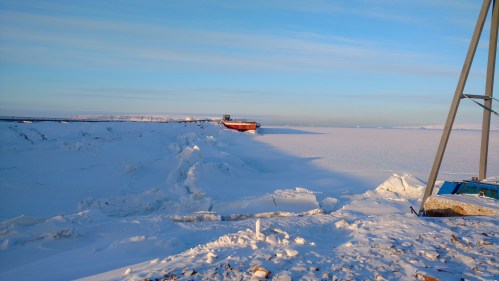I am heading to North Greenland in 3 days time to work where temperatures will be close to -20 F. The ocean is covered by 3-4 feet of sea ice that is frozen to land. We will drill lots of ice holes to deploy ocean sensors that will connect via cables to weather stations and satellite phone. Fancy $20,000 GPS units will measure the tides across the fjord and provide a group of future Naval officers a reference for their fancy electronic gear to measure sea ice thickness remotely by walking and comparing results to those obtained from planes overhead. Cool and cold fun.

The ocean pier at Thule Air Base in Greenland in March 2017. The view is towards the north-west along my proposed mooring line [Photo Credit: Sean Baker]

Cot, air mattress, and down sleeping bag testing in my garden after a rough night.
The clear skies over Thule during the 2 weeks that the sun is up again also gave me the first Landsat image. It shows the landfast sea ice, but it also shows its very limited extend as very thin ice and perhaps even open water occurs while the winds blow along the coast from the north. This cold wind moves the mobile sea ice offshore to the west thus opening up the oceans that will promptly freeze, however, the back ocean still shows under the inch-thin new ice:

Wolstenholme Fjord as seen by LandSat on Feb.-27, 2017. The line with the red dots extends from Thule pier seaward towards the north-west. Note the dark spot near the left-top corner that shows thin new ice or even open water. White contours are ocean depths in meters.
This thin new ice is the limit of where I expect to be working. After measuring ice thickness directly via drilling through the ice, my first measurement will be that of how temperature and salinity varies from under the ice to the bottom of the ocean.
![Working on the sea ice off northern Greenland [Photo credit, Steffen Olsen]](https://icyseas.org/wp-content/uploads/2016/12/image002.jpg?w=500&h=375)
Working on the sea ice off northern Greenland [Photo credit, Steffen Olsen]
I am very poor at making knots as my hand-eye co-ordination and memory is poor. So I spent some time this week to learn about knots such as
that should work on my braided Kevlar lines that I connect to shackles

Fancy knots on shackles in my home office … yes, Peter Freuchen is on the bookshelf, too.
There are always devils in the many details of field work. Another worry is that my 10” ice-drill is powered by 1 lbs bottles of propane. It is not possible to send these camping propane canisters via air, but larger 20 lbs tanks exist in Thule for grill cooking at the NSF dormitory where I will be staying. So I also will have to learn how to fill the smaller container from the large one. Just ordered another adaptor from Amazon to travel with me on my body to do this.
I am both terribly nervous and excited about the next 6 weeks. This is my first time working on the ice, because before I have always been on icebreakers in summer. These past Arctic summer expeditions on ships created an unreal and distant connection that, I hope, will be shattered by this spring. I will get closer to the cold and icy seas that are my passion. Oceanography by walking on water … ice.


While impressed by the sight of the old book on your bookshelf; Four Years in the White North, may I be so bold as to also suggest everyone read; Lost in the Arctic by Capt Ejnar Mikkelsen, being the story of The “Alabama” Expedition, 1909-1912, William Heinemann 1913.
Chris: It is on my list and hopefully will travel with me when heading to north-east Greenland later this year to recover ocean moorings adjacent to 79N Glacier off North-East Greenland where Einar Mikkelsen vanished with his two companions while exploring the area on foot. Incidentally, the older books are those ringed binders that are Lauge Koch’s 1928 scientific summary of glaciers and Knud Rasmussen’s 1912 report from his first of seven Thule Expeditions.
Andreas; thank you. One correction, the book is about the search for the diaries of the lost expedition of Mylius Erichsen and his two companions and is a very thought provoking description of the dreadful conditions faced by anyone attempting to survive for years within the Arctic Circle without external support. I will not say more as it will spoil the read. May I wish you and your companions a successful expedition and a safe return.
Wishing you safe, interesting and productive travels (from the ASIF).
The area around Thule Air Base and the Fjord is beautiful. I was there for a year. Years ago the base was connected to the US with an underwater cable. Make sure to stop in the Top of the World Club for some outstanding food. My FB page has some pics of Thule. Good luck!